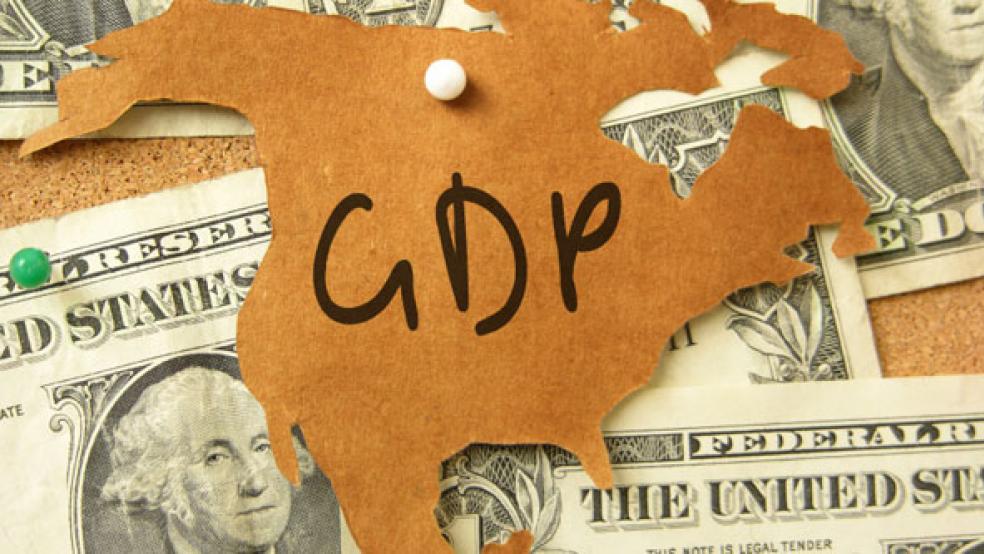The GDP data released Wednesday rewrites recent economic history to reveal a story that is ever-so-slightly happier.
The U.S. economy grew at an annual rate of 1.7 percent in the second quarter, according to the Bureau of Economic Analysis – a sluggish pace that was still significantly better than the 1 percent economists had expected. At the same time, first quarter growth was revised lower, from 1.8 percent to 1.1 percent.

Both the expected numbers and the actual ones pegged economic growth for the first half of 2013 at an average rate of 1.4 percent, but Wednesday’s data allow for a somewhat more optimistic interpretation, one that shows an economy that is building a bit of momentum rather than one that is stalling out. “Overall,” writes J.P. Morgan economist Michael Feroli, “the first half growth trajectory now looks a little better than before the report, even if average growth in [the first half] is about what was expected.” That somewhat brighter picture reinforces the Federal Reserve’s reading of the economy and may heighten the likelihood a September start to the central bank’s so-called “tapering,” or a reduction in the rate of monthly bond purchases intended to stimulate growth and spending.
Comprehensive revisions for past years also add to that modestly improved view, showing that the recession was less severe and the recovery has been a touch stronger than previously thought. Growth for last year was revised upward, from 2.2 percent to 2.8 percent, even as the updated data showed a very uneven year, with the second half even weaker than thought. In all, the data now show an economy that has gone from 0.1 percent growth over the final three months of 2012 (revised down from 0.4 percent) to 1.1 percent at the start of 2013 and then 1.7 percent in the most recent quarter.
Those numbers certainly don’t indicate an economy firing on all cylinders, as the economy in the first half of 2013 slowed relative to the full-year pace of 2012. Even if the economy improves markedly in the second half of 2013, the full-year gains won’t match the revised growth rate from late year. Yet the recent trends, combined with the revised data for past years, offer slightly more reason for encouragement. “The message of the revised GDP numbers is clear: After almost stagnating in late 2012, the economy has gradually been regaining momentum throughout the first half of this year,” UniCredit economist Harm Bandholz wrote in a note to clients.
RELATED: HOW ZOMBIES ARE NOW BOOSTING AMERICA'S GDP
The updated numbers also help to explain the discrepancy between what had been weak GDP numbers and more robust job gains. “The contour of the recovery,” economist Diane Swonk of Mesirow Financial wrote Wednesday, “did show more momentum in 2012 than previously reported, which helps explain some of the strength in employment gains that we saw late last year and the spillover into this early 2013. The question is whether that improvement is sustainable.” Even with the revised data, the gap between GDP growth and job creation persists, though. “Real GDP is up 1.4 percent in the last four quarters, which still looks very weak compared with the employment data--which look consistent with at least a 3 percent pace,” noted economist Jim O’Sullivan of High Frequency Economics.
The second quarter data show that businesses increased their spending 4.6 percent after cutting it by that much in the first three months of the year. Businesses also built up their inventories by $56.7 billion – an “astonishing” rise that added 0.4 percentage points to growth, according to economist Ian Shepherdson of Pantheon Macroeconomics. That might signal that companies expect economic conditions to improve in the second half of the year, but economists like Shepherdson warn that the number is likely to be revised lower.
Consumer spending, which is the biggest driver of the economy, grew 1.8 percent, a slower pace than the 2.3 percent gain in the first quarter. Much of that deceleration can be explained by lower spending on energy, Swonk wrote. The continued spending suggests that consumers have withstood the hits from the end of the payroll tax holiday and the introduction of sequestration cuts to federal spending. “Against this backdrop it is actually quite remarkable, how resilient above all the household sector has been throughout this period,” Bandholz wrote.
The government continues to be a drag on the economy, though. Federal spending dropped by 1.5 percent, better than the 8.4 percent pullback from the first quarter and the 13.9 percent drop in the last quarter of 2012. State and local governments increased their spending. As the fiscal drag from government subsides – assuming that renewed budget fights in Washington don’t result in a disruptive federal shutdown – and with recent data for the third quarter pointing to continued overall economic improvement, many analysts say the Fed remains on a path to start winding down its bond buying in September. Whether or not that outlook changes will still rest on new data, like the jobs report for July being released on Friday.





